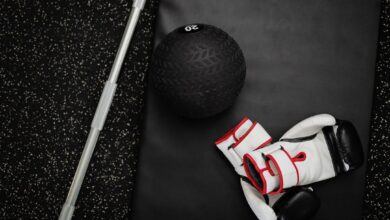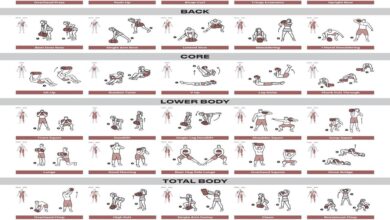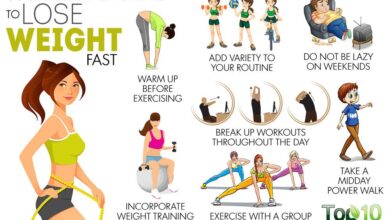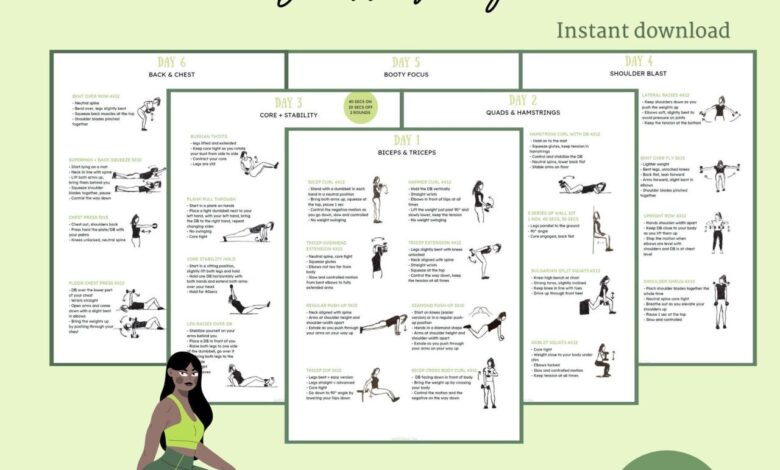
2 Week Progressive Dumbbell Workout Guide: Build Strength and Muscle
The 2 Week Progressive Dumbbell Workout Guide is your roadmap to a stronger, more sculpted physique. This plan utilizes the power of progressive overload, a key principle of strength training, to push your limits and unlock your full potential. Whether you’re a seasoned lifter or a newbie to the gym, this guide will provide a structured and effective program that caters to your individual needs.
Get ready to experience the transformative benefits of dumbbell workouts. This program is designed to target all major muscle groups, boosting your strength, endurance, and overall fitness. We’ll break down the principles of progressive overload, guide you through a series of effective dumbbell exercises, and provide insights into nutrition and recovery to maximize your results.
Introduction
Progressive dumbbell workouts are a highly effective and versatile way to build strength, muscle mass, and improve overall fitness. Dumbbells offer a wide range of exercises that target various muscle groups, allowing for a personalized approach to training. This guide will provide you with a comprehensive 2-week plan, incorporating the principles of progressive overload to help you achieve your fitness goals.
Benefits of Dumbbell Training
Dumbbells offer numerous advantages over other forms of strength training, making them an excellent choice for individuals of all fitness levels.
- Versatility:Dumbbells allow for a wide range of exercises, targeting all major muscle groups, from squats and deadlifts to bicep curls and shoulder presses.
- Improved Stability and Balance:Using dumbbells requires greater stability and balance compared to machines, which helps improve overall coordination and control.
- Increased Muscle Activation:Dumbbell exercises often involve a greater range of motion, leading to increased muscle activation and potential for greater muscle growth.
- Convenience:Dumbbells are relatively inexpensive and portable, allowing you to train at home or at the gym without needing specialized equipment.
Progressive Overload
Progressive overload is a fundamental principle of strength training that involves gradually increasing the demands placed on your muscles over time. This can be achieved by increasing the weight, repetitions, or sets, or by adding new exercises.
Progressive overload is the key to continuous muscle growth and strength gains.
By consistently challenging your muscles, you stimulate their adaptation and growth, leading to increased strength and muscle mass.
Workout Structure
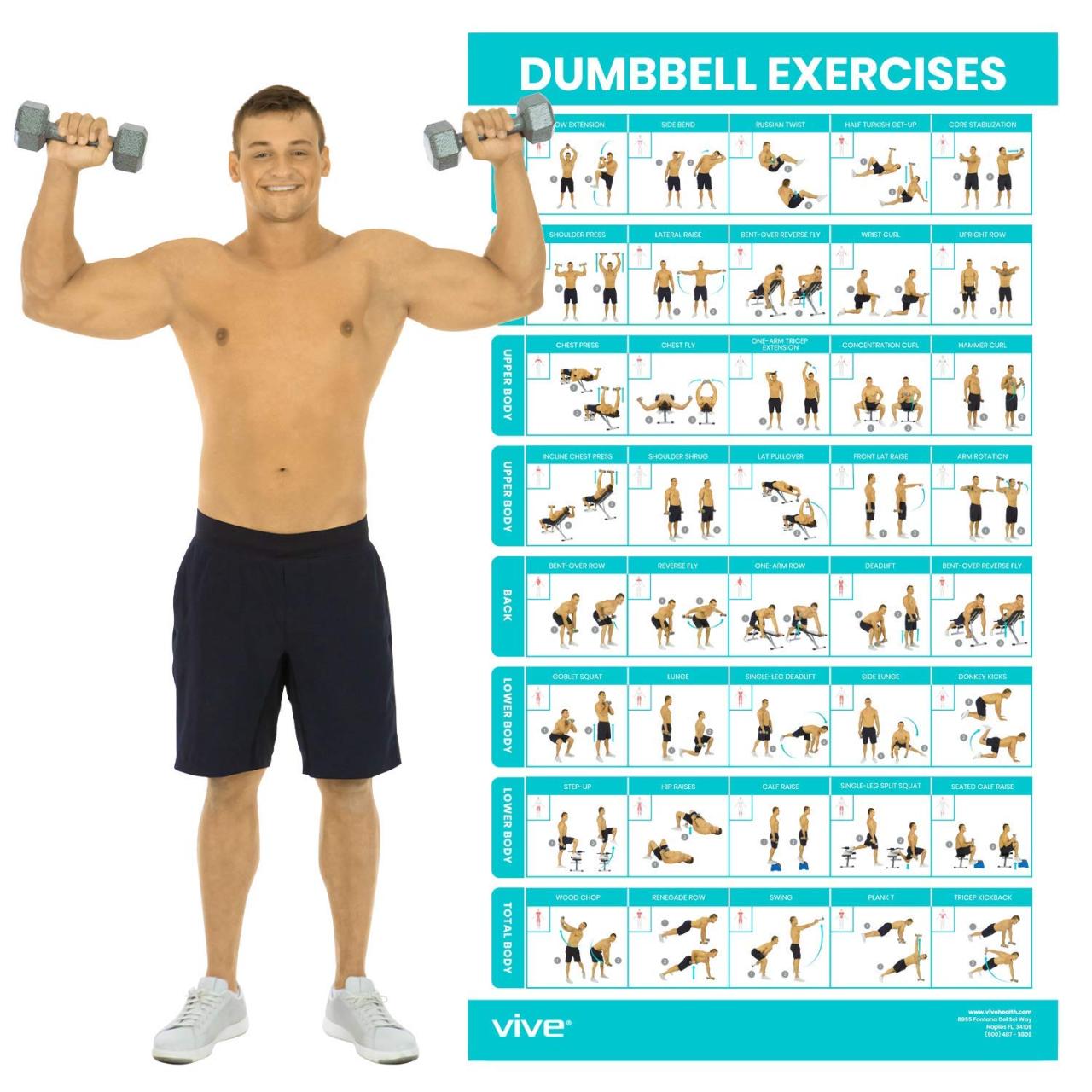
This workout plan is designed to help you build strength and muscle mass over two weeks. It follows a progressive overload principle, meaning you gradually increase the weight or resistance you lift over time. This challenges your muscles and encourages them to grow stronger.
Two-Week Workout Plan
The plan is structured to provide a balance of training and rest. Each week consists of four days of training, followed by three days of rest. This allows your body to recover and rebuild muscle tissue.
Sample Weekly Schedule
Here is a sample weekly schedule for this dumbbell workout program:| Day | Exercise | Sets | Reps | Rest ||—|—|—|—|—|| Monday| Chest & Triceps| | | || | Bench Press | 3 | 8-12 | 60 seconds || | Incline Dumbbell Press | 3 | 8-12 | 60 seconds || | Dumbbell Flyes | 3 | 10-15 | 60 seconds || | Triceps Extensions | 3 | 10-15 | 60 seconds || | Overhead Triceps Extensions | 3 | 10-15 | 60 seconds || Tuesday| Back & Biceps| | | || | Bent-Over Rows | 3 | 8-12 | 60 seconds || | Seated Cable Rows | 3 | 8-12 | 60 seconds || | Dumbbell Pullovers | 3 | 10-15 | 60 seconds || | Bicep Curls | 3 | 10-15 | 60 seconds || | Hammer Curls | 3 | 10-15 | 60 seconds || Wednesday| Rest| | | || Thursday| Legs & Shoulders| | | || | Squats | 3 | 8-12 | 60 seconds || | Lunges | 3 | 10-15 per leg | 60 seconds || | Calf Raises | 3 | 15-20 | 60 seconds || | Dumbbell Shoulder Press | 3 | 8-12 | 60 seconds || | Lateral Raises | 3 | 10-15 | 60 seconds || | Front Raises | 3 | 10-15 | 60 seconds || Friday| Full Body| | | || | Deadlifts | 3 | 5-8 | 90 seconds || | Push-Ups | 3 | As many as possible | 60 seconds || | Pull-Ups | 3 | As many as possible | 60 seconds || | Plank | 3 | 30-60 seconds | 60 seconds || Saturday| Rest| | | || Sunday| Rest| | | |
Remember to start with a weight that is challenging but allows you to maintain good form throughout the entire range of motion.
Exercise Selection
This section delves into the specific dumbbell exercises you’ll be performing throughout this two-week program. We’ve carefully chosen these exercises to target all major muscle groups, ensuring a well-rounded and effective workout. Each exercise description will provide detailed instructions on proper form and technique, helping you maximize your results while minimizing the risk of injury.
Chest Exercises
Dumbbell exercises are an excellent way to target the chest muscles, providing a versatile range of motion and allowing for progressive overload. Here are three effective dumbbell exercises for chest development:
- Dumbbell Bench Press: Lie on a weight bench with your feet flat on the floor. Hold dumbbells in each hand, palms facing each other. Lower the dumbbells towards your chest, keeping your elbows slightly bent. Push the dumbbells back up to the starting position.
Proper form: Maintain a slight arch in your lower back, keep your core engaged, and avoid letting the dumbbells touch your chest.
- Dumbbell Incline Bench Press: Similar to the flat bench press, but performed on an incline bench (typically 30-45 degrees). This variation targets the upper chest muscles more effectively.
Proper form: Keep your elbows slightly bent and avoid letting the dumbbells touch your chest.
- Dumbbell Flyes: Lie on a flat bench with your feet flat on the floor. Hold dumbbells in each hand, palms facing each other. Lower the dumbbells out to the sides, keeping your elbows slightly bent and maintaining a slight bend in your wrists.
Bring the dumbbells back up to the starting position.
Proper form: Maintain a slight arch in your lower back, keep your core engaged, and avoid letting the dumbbells touch your chest.
Back Exercises
Dumbbell exercises are also effective for building a strong and defined back. Here are three exercises targeting different back muscles:
- Dumbbell Rows: Stand with your feet shoulder-width apart, holding a dumbbell in each hand. Bend at the waist, keeping your back straight. Let the dumbbells hang down towards the floor. Pull the dumbbells up towards your chest, keeping your elbows close to your body.
Lower the dumbbells back down to the starting position.
Proper form: Maintain a straight back, engage your core, and avoid swinging your body.
- Dumbbell Pullovers: Lie on a bench with your feet flat on the floor. Hold a dumbbell with both hands, palms facing each other. Extend your arms straight up over your chest. Lower the dumbbell down behind your head, keeping your elbows slightly bent.
Bring the dumbbell back up to the starting position.
Proper form: Keep your core engaged and avoid arching your back.
- Dumbbell Shrugs: Stand with your feet shoulder-width apart, holding a dumbbell in each hand. Raise your shoulders towards your ears, keeping your back straight. Lower the dumbbells back down to the starting position.
Proper form: Maintain a straight back, engage your core, and avoid shrugging your shoulders too high.
A two-week progressive dumbbell workout guide can be a fantastic way to build strength and improve your overall fitness. But remember, consistency is key! If you’re feeling overwhelmed, don’t forget to take some time for yourself and check out these 8 quick ways to reduce stress right now.
By incorporating stress-reducing techniques into your routine, you’ll be better equipped to tackle those challenging workouts and see lasting results!
Leg Exercises
Dumbbell exercises offer a great way to strengthen and tone your leg muscles. Here are three exercises targeting different leg muscle groups:
- Dumbbell Squats: Stand with your feet shoulder-width apart, holding a dumbbell in each hand. Lower your body down as if you’re sitting in a chair, keeping your back straight and your core engaged. Push back up to the starting position.
Proper form: Maintain a straight back, engage your core, and avoid letting your knees go past your toes.
- Dumbbell Lunges: Stand with your feet hip-width apart, holding a dumbbell in each hand. Take a step forward with one leg, lowering your body until both knees are bent at a 90-degree angle. Push back up to the starting position.
Proper form: Maintain a straight back, engage your core, and avoid letting your front knee go past your toes.
- Dumbbell Romanian Deadlifts (RDLs): Stand with your feet shoulder-width apart, holding a dumbbell in each hand. Hinge at the hips, keeping your back straight and your core engaged. Lower the dumbbells towards the floor, keeping your knees slightly bent. Push back up to the starting position.
Proper form: Maintain a straight back, engage your core, and avoid letting your back round.
Arm Exercises
Dumbbell exercises are highly effective for targeting both the biceps and triceps, leading to increased strength and definition. Here are three exercises for each muscle group:
Biceps Exercises
- Dumbbell Bicep Curls: Stand with your feet shoulder-width apart, holding a dumbbell in each hand. Curl the dumbbells up towards your shoulders, keeping your elbows close to your body. Lower the dumbbells back down to the starting position.
Proper form: Maintain a straight back, engage your core, and avoid swinging your body.
- Dumbbell Hammer Curls: Stand with your feet shoulder-width apart, holding a dumbbell in each hand with your palms facing each other. Curl the dumbbells up towards your shoulders, keeping your elbows close to your body. Lower the dumbbells back down to the starting position.
Proper form: Maintain a straight back, engage your core, and avoid swinging your body.
- Dumbbell Concentration Curls: Sit on a bench with your feet flat on the floor. Hold a dumbbell in one hand, resting your elbow on the inside of your thigh. Curl the dumbbell up towards your shoulder, keeping your elbow close to your body.
Lower the dumbbell back down to the starting position.
Proper form: Maintain a straight back, engage your core, and avoid swinging your body.
Triceps Exercises
- Dumbbell Overhead Triceps Extensions: Stand with your feet shoulder-width apart, holding a dumbbell in one hand. Raise the dumbbell overhead, keeping your arm straight. Lower the dumbbell behind your head, keeping your elbow locked. Push the dumbbell back up to the starting position.
Proper form: Maintain a straight back, engage your core, and avoid letting your elbow bend.
- Dumbbell Triceps Kickbacks: Kneel on a bench with your chest facing the floor. Hold a dumbbell in one hand, keeping your arm straight. Kick the dumbbell back, keeping your elbow close to your body. Lower the dumbbell back down to the starting position.
Proper form: Maintain a straight back, engage your core, and avoid swinging your body.
- Dumbbell Close-Grip Bench Press: Lie on a weight bench with your feet flat on the floor. Hold dumbbells in each hand, palms facing each other. Lower the dumbbells towards your chest, keeping your elbows close to your body. Push the dumbbells back up to the starting position.
Proper form: Maintain a slight arch in your lower back, keep your core engaged, and avoid letting the dumbbells touch your chest.
Warm-up and Cool-down
Before diving into your dumbbell workout routine, it is crucial to prepare your body with a proper warm-up and cool down afterward. These phases are essential for optimizing performance, preventing injuries, and promoting recovery.A well-structured warm-up gradually increases your heart rate, blood flow, and muscle temperature, preparing your body for the physical demands of your workout.
Conversely, a cool-down helps your body transition back to a resting state, minimizing muscle soreness and promoting recovery.
Warm-up Routine, 2 week progressive dumbbell workout guide
A comprehensive warm-up should consist of dynamic stretches and light cardio. This approach helps improve flexibility, range of motion, and muscle activation.Here’s a sample warm-up routine you can adapt to your needs:
- Cardio:Start with 5-10 minutes of light cardio, such as jogging in place, jumping jacks, or brisk walking. This will elevate your heart rate and prepare your cardiovascular system for the workout.
- Dynamic Stretching:Follow the cardio with a series of dynamic stretches, focusing on major muscle groups. Examples include arm circles, leg swings, torso twists, and high knees.
Cool-down Routine
A cool-down allows your body to gradually recover from the workout. It helps reduce muscle soreness, improve flexibility, and prevent stiffness.Here’s a sample cool-down routine:
- Light Cardio:Begin with 5-10 minutes of light cardio, such as walking or slow jogging. This will help reduce your heart rate and promote blood flow.
- Static Stretching:Hold each static stretch for 30 seconds, focusing on major muscle groups used during the workout. Examples include holding a hamstring stretch, a quadriceps stretch, or a calf stretch.
Importance of Warm-up and Cool-down
Proper warm-up and cool-down are crucial for injury prevention and performance enhancement.
- Injury Prevention:Warming up helps increase blood flow to muscles, making them more pliable and less prone to tears or strains. It also prepares your joints for movement, reducing the risk of sprains or dislocations. Cooling down helps reduce muscle stiffness and soreness, minimizing the risk of delayed-onset muscle soreness (DOMS).
- Performance Enhancement:A proper warm-up improves muscle activation, allowing you to lift heavier weights and perform exercises with greater efficiency. It also enhances flexibility and range of motion, contributing to better form and technique. Cooling down helps your body recover faster, allowing you to perform better in subsequent workouts.
Nutrition and Recovery
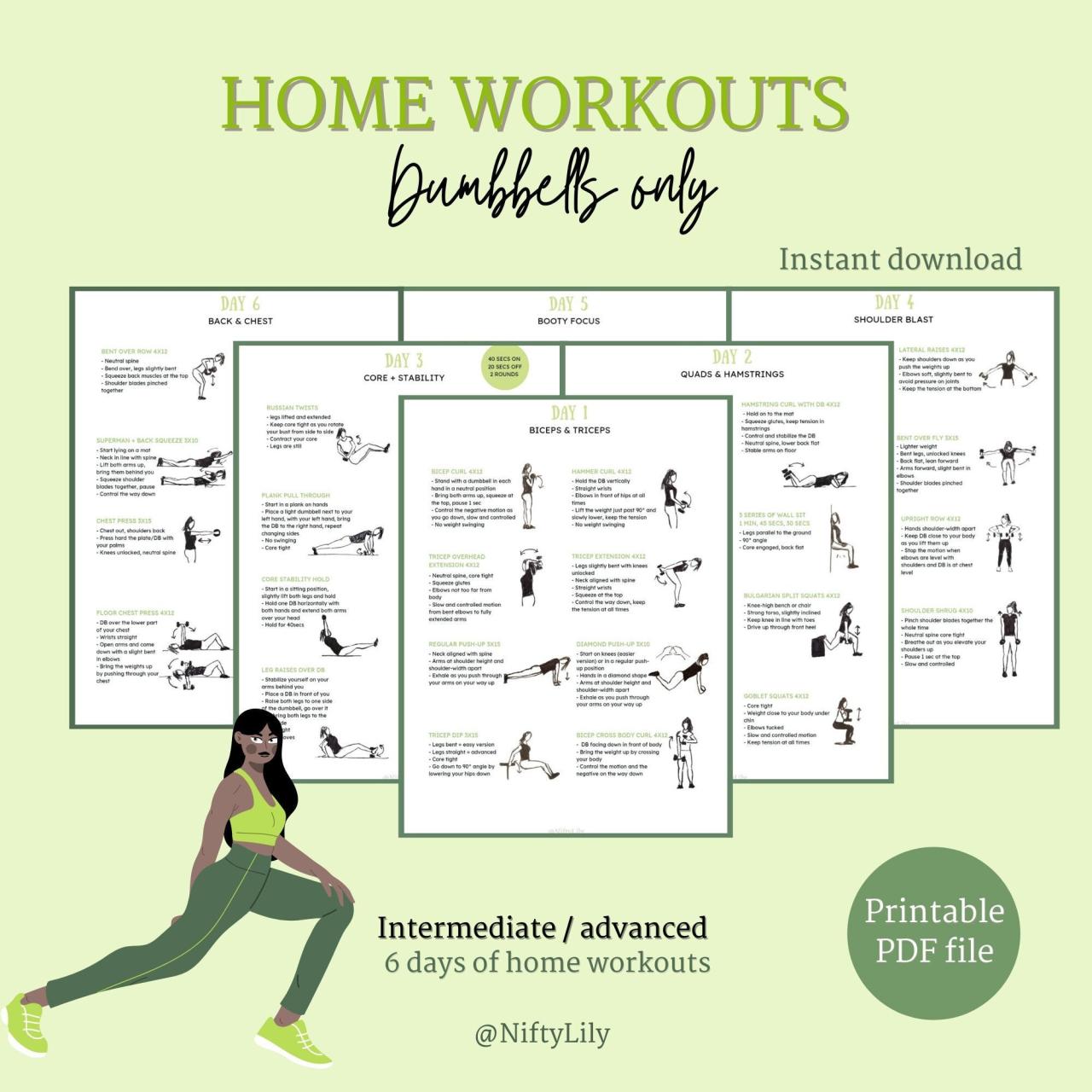
Fueling your body with the right nutrients is essential for muscle growth and recovery, as crucial as the workouts themselves. This section explores how to optimize your nutrition for optimal results from your dumbbell program.
A 2-week progressive dumbbell workout guide can be a great way to build strength and muscle at home. It’s all about consistency and pushing yourself, just like Brianna did in her incredible journey, how Brianna went from giving up to giving it her all.
You’ll find that each week, the workouts get more challenging, so you’re constantly progressing and seeing results. This guide is perfect for beginners and those looking to take their fitness to the next level.
Pre-Workout Meals
Pre-workout nutrition plays a vital role in providing your body with the energy it needs to power through your workout. It’s crucial to consume a balanced meal containing carbohydrates and protein around 1-2 hours before your training session.
- Carbohydrates:Provide energy for your muscles, helping you perform at your best during your workout. Good sources include oatmeal, whole-grain toast, or a banana.
- Protein:Promotes muscle repair and growth, ensuring your body has the building blocks it needs to recover from your workout. Examples include Greek yogurt, eggs, or a protein shake.
Post-Workout Meals
Post-workout meals are critical for replenishing energy stores and initiating muscle recovery. It’s important to consume a meal rich in protein and carbohydrates within 30-60 minutes after your workout.
A two-week progressive dumbbell workout guide can help you build strength and muscle, but don’t forget the importance of quality time with your loved ones! A simple walk together can do wonders for your relationship, as it provides a chance to connect and de-stress.
Read more about how walking together helps you stay together and then get back to crushing those dumbbell workouts!
- Protein:Helps repair and rebuild muscle tissue, facilitating growth and strength gains. Good sources include chicken breast, fish, or a protein shake.
- Carbohydrates:Replenish glycogen stores, providing energy for recovery and future workouts. Examples include sweet potatoes, brown rice, or quinoa.
Role of Sleep and Hydration
Adequate sleep and hydration are essential for muscle recovery and overall well-being. Sleep allows your body to repair and rebuild muscle tissue, while hydration supports various physiological processes, including nutrient transport and waste removal.
- Sleep:Aim for 7-9 hours of quality sleep each night to allow your body to recover effectively.
- Hydration:Drink plenty of water throughout the day, especially before, during, and after your workouts.
Safety and Precautions
Dumbbell workouts can be highly effective for building strength and muscle, but it’s crucial to prioritize safety to avoid injuries. Understanding common mistakes, proper form, and when to seek professional help will help you maximize your gains while minimizing risks.
Common Mistakes to Avoid
It’s essential to be aware of common mistakes that can compromise your safety and effectiveness during dumbbell workouts. These mistakes can lead to muscle imbalances, poor form, and even injuries.
- Using Excessive Weight:Lifting weights that are too heavy can lead to poor form, muscle strain, and even serious injuries. It’s always better to start with a lighter weight and gradually increase it as you get stronger.
- Ignoring Proper Form:Incorrect form can put unnecessary stress on your joints and muscles, increasing the risk of injury. Focusing on maintaining proper form is crucial, even if it means using lighter weights.
- Neglecting Warm-up and Cool-down:A proper warm-up prepares your body for the workout, while a cool-down helps prevent muscle soreness and stiffness. Skipping these crucial phases can increase your risk of injury.
- Training Too Frequently:Overtraining can lead to muscle fatigue, decreased performance, and increased risk of injury. Allowing your body adequate rest and recovery time is essential for muscle growth and overall well-being.
- Ignoring Pain Signals:If you experience pain during your workout, stop immediately and consult with a healthcare professional. Pushing through pain can worsen the injury and delay recovery.
Proper Form and Technique
Maintaining proper form during dumbbell exercises is critical for maximizing effectiveness and minimizing the risk of injury.
- Engage Your Core:Engaging your core muscles provides stability and support during lifts, reducing strain on your back and preventing injury.
- Control the Movement:Avoid jerky movements and focus on controlled, smooth motions throughout the exercise. This helps maintain proper form and reduces stress on your joints.
- Maintain a Neutral Spine:Keep your spine aligned throughout the exercise, avoiding excessive arching or rounding. This helps protect your back from injury.
- Full Range of Motion:Perform exercises through the full range of motion, ensuring proper muscle activation and preventing muscle imbalances.
- Breathe Properly:Exhale during the exertion phase of the lift (concentric contraction) and inhale during the return phase (eccentric contraction). This helps maintain proper form and reduces strain on your body.
Seeking Professional Help
If you’re unsure about proper form, have any underlying medical conditions, or experience persistent pain, it’s crucial to consult with a qualified professional.
- Personal Trainer:A certified personal trainer can provide personalized guidance on proper form, exercise selection, and workout programming to help you achieve your fitness goals safely.
- Physical Therapist:If you have any injuries or concerns about your physical limitations, a physical therapist can assess your condition, develop a rehabilitation plan, and provide exercises to help you recover and prevent future injuries.
- Physician:If you experience persistent pain, dizziness, or other concerning symptoms, consult your physician for a medical evaluation. They can rule out any underlying medical conditions and recommend appropriate treatment.
Variations and Modifications
This dumbbell workout guide is designed to be adaptable to different fitness levels and individual preferences. You can modify the exercises, weights, and sets to suit your needs.
Here are some variations and modifications you can consider:
Alternative Exercises
If you find certain exercises challenging or want to try something different, you can substitute them with other exercises that target the same muscle groups. Here are some alternatives:
- Bicep Curls:Hammer curls, concentration curls, preacher curls
- Triceps Extensions:Overhead triceps extensions, close-grip bench press, skull crushers
- Shoulder Press:Lateral raises, front raises, Arnold press
- Squats:Goblet squats, Bulgarian split squats, lunges
- Deadlifts:Romanian deadlifts, sumo deadlifts, single-leg deadlifts
- Rows:Bent-over rows, seated rows, T-bar rows
Modifications for Specific Limitations
If you have any injuries or limitations, you can modify the exercises to make them more comfortable and safe. Here are some tips:
- Joint Pain:Use lighter weights, reduce the range of motion, or avoid exercises that put stress on the affected joint.
- Back Pain:Avoid exercises that involve heavy lifting or twisting movements. You can try modified versions of exercises like squats and deadlifts with a lighter weight or by using a chair for support.
- Knee Pain:Avoid exercises that put pressure on your knees, such as deep squats or lunges. You can try modified versions of these exercises by using a chair for support or by reducing the range of motion.
Adjusting the Workout Plan
You can adjust the workout plan based on your individual goals and preferences. For example:
- Increase the weight:If you find the exercises too easy, you can increase the weight to challenge yourself.
- Increase the repetitions:If you want to build muscle endurance, you can increase the number of repetitions for each exercise.
- Increase the sets:If you want to increase the intensity of your workout, you can increase the number of sets for each exercise.
- Add more exercises:If you want to target specific muscle groups, you can add more exercises to your workout.
- Change the frequency:You can adjust the frequency of your workouts based on your recovery needs. If you’re feeling sore, you may want to take a day off or reduce the intensity of your workouts.
Motivation and Consistency
Sticking to a workout plan can be challenging, but with the right mindset and strategies, you can achieve your fitness goals. Consistency is key, and motivation plays a crucial role in helping you stay on track.
Setting Realistic Goals
Setting realistic goals is essential for maintaining motivation. Instead of aiming for drastic changes, focus on making gradual progress. For example, if you’re new to exercise, start with two or three workouts per week and gradually increase the frequency and intensity.
Celebrate your achievements along the way, no matter how small they may seem.
Creating a Workout Routine
Develop a workout routine that you enjoy and that fits your lifestyle. If you find yourself dreading your workouts, it’s less likely that you’ll stick with them. Choose activities that you find engaging and challenging, and consider incorporating variety to prevent boredom.
Finding a Workout Buddy
Having a workout buddy can provide motivation and accountability. Find a friend or family member who shares similar fitness goals and can support you along the way. Working out together can make the experience more enjoyable and help you stay committed.
Tracking Your Progress
Tracking your progress can help you stay motivated and see how far you’ve come. Keep a workout journal or use a fitness tracker to record your workouts, weightlifting progress, and other metrics. Seeing your progress can be a powerful motivator and inspire you to continue pushing yourself.
Rewarding Yourself
Rewarding yourself for achieving milestones can help you stay motivated. Set small goals and reward yourself for reaching them. These rewards can be anything from a new workout outfit to a relaxing massage.
Listening to Your Body
It’s crucial to listen to your body and take rest days when needed. Pushing yourself too hard can lead to injury and burnout. Rest days are just as important as workout days, as they allow your body to recover and rebuild muscle.
Last Point: 2 Week Progressive Dumbbell Workout Guide
Embark on this 2 Week Progressive Dumbbell Workout Guide and witness the remarkable transformation of your body and mind. Remember, consistency is key! Follow the plan, listen to your body, and celebrate your progress. You’ll not only gain strength and muscle, but also cultivate a sense of accomplishment and confidence that extends beyond the gym.


